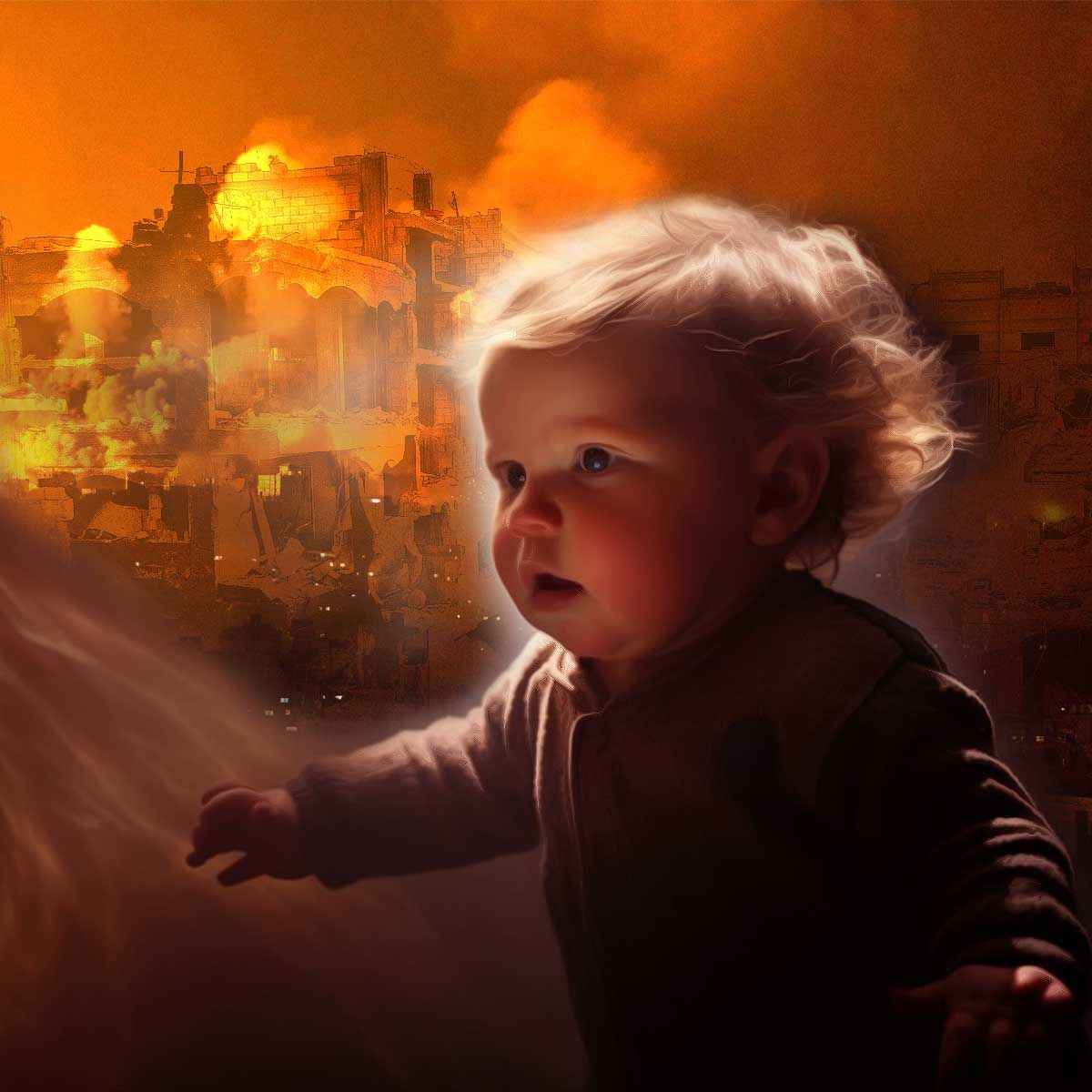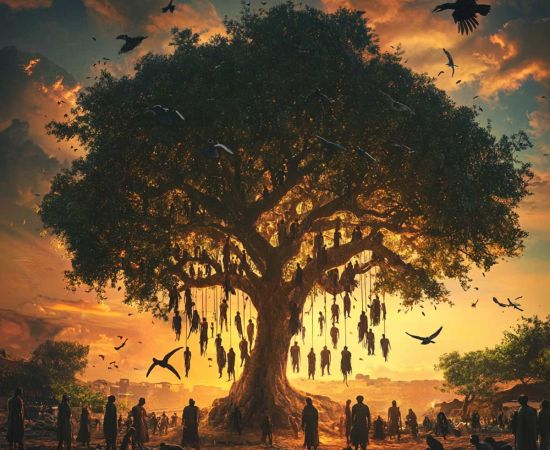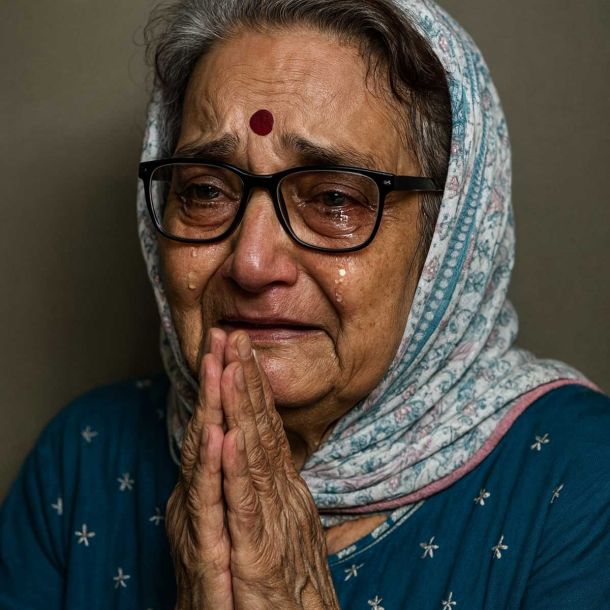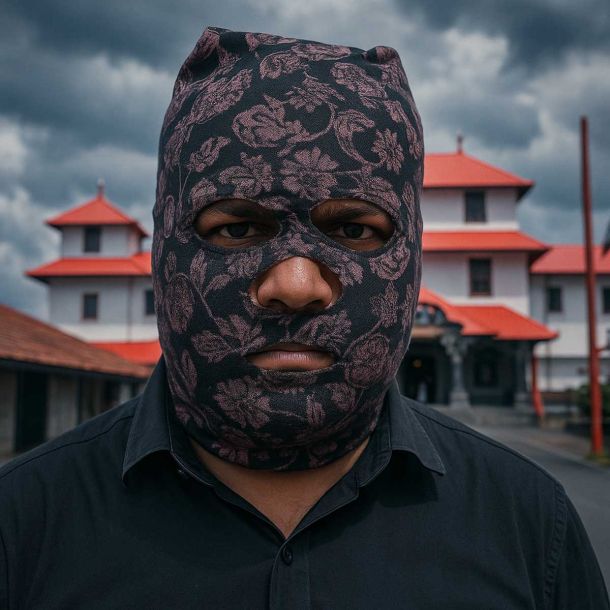MORE COVERAGE
Twitter Coverage
Satyaagrah
Written on
Satyaagrah
Written on
Satyaagrah
Written on
Satyaagrah
Written on
Satyaagrah
Written on
JOIN SATYAAGRAH SOCIAL MEDIA
"Behind every shield, a heart still beats": As the Hamas-Israel conflict intensifies, innocent Israeli babies confront horrors beyond imagination, amidst fragile diplomatic efforts, these souls are caught in a war's crossfire, bearing heart-wrenching toll

In a deeply unsettling move, Hamas has unveiled a 49-second video clip that appears to showcase terrorists handling Israeli babies and young children. The content of the footage is disturbing, to say the least.
|
One particular scene in the video depicts a gunman, with a visibly distressed baby laid atop his rifle, drawing immediate concern and disbelief from viewers. Another segment reveals a baby making gurgling sounds, seemingly unperturbed, as a Hamas terrorist gently pats its back while departing what appears to be a residential living room.
Further amplifying the alarm, the video features a young boy seated on a terrorist's lap in what seems to be a garden setting of a family residence. This child, surrounded by a group of at least eight more terrorists, paints a harrowing picture.
Additionally, in one of the frames, a masked individual can be seen holding a young boy and an infant, addressing the camera in Arabic.
This footage is a stark reminder of the complex and sensitive nature of the ongoing conflict, and raises grave concerns about the safety and well-being of children caught in the crossfire. The exact intentions behind the release of this video remain unclear, but its impact is undeniably profound and deeply troubling.
The origins and the circumstances surrounding the alarming footage released by Hamas are shrouded in mystery. Key details such as the exact location and timing of the recording remain undisclosed. Equally distressing is the uncertainty about the well-being of the children showcased in the video, as well as the status of their parents.
This 49-second video, which has already sent shockwaves globally, depicts a masked individual addressing the camera in Arabic, all the while holding a young boy and an infant.
|
The release of this disturbing footage comes at a time of heightened tensions in the region. The Israel Defense Forces are gearing up for a ground assault in Gaza, following their advisory to 1.1 million civilians to vacate their homes as a precautionary measure. This directive follows in the wake of Hamas' attack last Saturday, which has resulted in the tragic loss or abduction of several Israeli children.
A growing concern, amplifying the already tense situation, is the fear that over 100 Israeli hostages might be exploited by terrorists as human shields. The entire scenario underscores the dire complexities and the profound human cost of the ongoing conflict.
In what seems to be a response to the chilling video released by Hamas, the Israeli government has publicized several harrowing images purportedly showcasing the aftermath of Hamas' actions.
Among the images, one particularly haunting photograph reveals an infant, clothed in a babygrow and diaper, stained with blood and placed inside a diminutive body bag. The emotional weight of this image led the Israeli government's foreign ministry to admit their struggle over its publication. In a poignant Twitter post, they expressed, “This is the most difficult image we’ve ever posted. As we are writing this, we are shaking,” adding, “We went back and forth about posting this, but we need each and every one of you to know. This happened.”
The foreign ministry did not stop there. Last Friday, two additional graphic images were shared. One captured the grim sight of a man with a gunshot wound to his head, and the other depicted a lifeless, partially clothed body being transported away on a motorcycle.
The accompanying message was stark and powerful, drawing a hard line comparison: “Women and girls raped. People burned alive. Young kids kidnapped. Babies tortured and murdered. Parents executed in front of their young children. Hamas is ISIS.”
These exchanges of distressing media underscore the profound tragedy and complexities of the conflict, pulling at the heartstrings of observers worldwide. The intensity of the situation is palpable, with both sides seemingly desperate to convey the depths of their anguish and the gravity of the situation.
|
Israeli Hostages at the Forefront of the Escalating Hamas-Israel Conflict
In a recent piece featured in Dal News, Robert Huish, an associate professor of International Development Studies at Dalhousie University, delves into the deeply concerning matter of Israeli hostages amidst the raging Hamas-Israel war.
Historically, Gaza has been a fortress, with stringent restrictions making it exceedingly challenging to move people or items across its borders. However, the dynamics witnessed a dramatic shift this past weekend. Gaza became the source of a torrential outpour of rockets, and in a grim turn of events, over 100 Israelis found themselves held captive by Hamas.
Israel's voice at the United Nations, Ambassador Gilad Erdan, provided a specific range, stating that the number of hostages taken lies somewhere between 100 and 150. Adding to the gravity of the situation, The Times of Israel has reported that the identities of most of these hostages have been ascertained, with their families receiving heart-wrenching notifications.
Further fueling the tension, Hamas has recorded and disseminated videos depicting the abductions of Israelis. These videos have been widely circulated on social media platforms and WhatsApp groups.
|
Yet, one of the most pressing questions remains unanswered: Where are these hostages currently held? As the conflict intensifies, the answer remains distressingly elusive.
As the Hamas-Israel conflict escalates, efforts to mediate and bring some semblance of resolution are underway. Qatari officials have stepped into this volatile arena, proposing a prisoner exchange. The deal on the table involves the release of 36 Palestinian women and children currently in Israeli custody in return for the hostages seized by Hamas. However, Hamas has signaled its reluctance, stating that they won't enter into any "prisoner exchange" dialogues until the conflict sees its end.
The unfolding of these events leads to some critical interpretations.
Could it be a Strategy to Deter Retaliation? One possible inference is that by dispersing Israeli hostages across Gaza, Hamas aims to deter significant Israeli airstrikes or even a potential ground invasion by the Israeli defense forces.
Or Uncertainty Within Hamas? Another perspective suggests that Hamas might be grappling with internal chaos, potentially unaware of the exact number of hostages they hold or their identities.
Further compounding the situation's gravity, distressing video content has emerged. Some footage chillingly showcases Israeli hostages being executed in Gaza by Hamas militants wielding assault rifles. In another disturbing clip, a German woman is seen being paraded through Gaza's streets.
|
|
This isn't the first instance where Israelis have been subjected to hostage situations. A historical precedent dates back to 1985 when a Trans World Airlines flight, carrying 139 passengers and an eight-member crew, was hijacked by two Lebanese terrorists. Their demand? The release of 700 Shi'ite Muslims imprisoned by Israel.
The current conflict and its multifaceted implications underscore the dire need for a peaceful resolution, not just for the immediate stakeholders but for the broader global community.
History has seen multiple instances of prisoner exchanges in the Israeli-Palestinian conflict. Notably, in 2011, a staggering 1,027 Palestinians were freed in exchange for the release of one Israeli soldier, Gilad Shalit, who had been held by Hamas since 2006. Then, in 2014, the world watched in horror as Hamas abducted and subsequently executed three Israeli teenagers.
However, the current situation delineates from these precedents.
Not Your Typical Prisoner Diplomacy This isn't a mere extension of past prisoner diplomacy, where one side tries to free their own by exchanging them for prisoners from the opposing faction. It's not a proxy diplomatic skirmish involving civilian prisoners, akin to the Canada-China exchange revolving around Chinese telecommunications executive Meng Wanzhou and the "Two Michaels."
|
Instead, what we're witnessing is a calculated, highly orchestrated maneuver by Hamas, designed with three distinct political objectives in mind.
A Bid to Disrupt Diplomacy: By holding Israeli hostages, Hamas seems to be aiming to derail the budding diplomatic ties between Israel and Saudi Arabia.
Mocking Political Adversaries: The situation appears to serve as a direct challenge to Benjamin Netanyahu's aggressive war hawk stance, ridiculing his platform and tactics.
Questioning Fatah's Authority: Lastly, by executing such a high-stakes move, Hamas could be attempting to destabilize Fatah's proclaimed role as the voice and representative of the Palestinian people.
The profound implications of this strategic shift by Hamas signify an evolution in their tactics and objectives, potentially reshaping the dynamics of the Middle Eastern conflict.
The Palestinian factions, Hamas and Fatah, have long held differing views on the Israeli-Palestinian conflict. Hamas, historically, has been a proponent of armed resistance and has unapologetically called for the annihilation of Israel. On the contrary, Fatah adopts a more diplomatic stance, pushing for negotiations with Israel and championing a two-state solution. They have firmly distanced themselves from using force as a means to achieve their objectives.
|
A Horrifying Reality for Hostages The present situation in Gaza paints a bleak picture for the Israeli hostages. Their reality is a harrowing one, where displacement, perpetual stress, and the looming danger of being used as human shields are daily truths.
Furthermore, the audacity with which Hamas executed this operation is alarming. It prompts pressing questions about their backing – who's facilitating, arming, and equipping them? Recent revelations include Israel's interception of chemicals intended for rocket fuel production. Intelligence reports also indicate that Hamas's arsenal is being replenished through intricate smuggling routes, which include intricate sea-to-sea transfers.
Post the initial onslaught, there's a palpable sense that Hamas is bracing for an Israeli ground incursion. They're possibly banking on Israel's internal political turmoil and speculating that Israel's aerial target list has become obsolete.
Should a ground confrontation ensue between Hamas and Israeli troops, the hostages, tragically, are poised to be at the epicenter of this clash.
For this conflict, the Israeli hostages aren't mere pawns in a diplomatic game. They stand at the perilous intersection of what promises to be a relentless and savage battle. The stakes are incredibly high, and the world watches with bated breath as the situation continues to unfold. The Conversation
|
Israel Unveils Disturbing Images of Casualties Caused by Hamas
In a deeply unsettling move, Israeli authorities released a series of graphic photos on Thursday, corroborating their claims about Hamas targeting children and infants. This decision came in the wake of the US Secretary of State's allegations that the Islamist group was employing Gaza's civilian population as "human shields."
Earlier on Thursday, the White House retracted President Biden's statement regarding his having seen images of decapitated children. They clarified that the President was alluding to reports emanating from Israel and had not personally viewed such photos.
In a prompt response, the Israeli government presented a collection of photos and video evidence to US Secretary of State Antony Blinken and also shared some on various social media platforms. Commenting on the chilling imagery, Blinken remarked, "Pictures are worth a thousand words. These pictures may be worth a million."
The ongoing conflict has exacted a heavy toll, with over 1,300 fatalities and 3,200 injured on the Israeli side due to the extensive assault by Hamas. In retaliation, Israeli airstrikes in Gaza have resulted in at least 1,400 deaths and injuries to more than 6,000 individuals.
|
Gruesome Content Surfaces Online / In an unsettling move, graphic photos showcasing injured babies and children, along with rooms drenched in blood and gunpowder, were unveiled on official social media platforms of the State of Israel and Prime Minister Benjamin Netanyahu, specifically on X, which previously operated as Twitter.
The state's account fervently stated, “Those who deny these events are supporting the barbaric animals who are responsible for them. Babies. Toddlers. Infants,”. This was in direct response to emerging skepticism on social media platforms, where questions have arisen regarding the authenticity of a report that claimed 40 infants had been beheaded by Hamas.
In a press conference held in Tel Aviv, the American Secretary of State disclosed that the Israeli authorities presented him with harrowing images from a recent Hamas attack in southern Israel. These images bore testimony to the heinous nature of the attack, depicting an infant fatally shot, soldiers decapitated, and teenagers set ablaze while attempting to escape, among other atrocities.
Attributing such acts of violence to "pure evil", the Secretary pointed fingers at the Palestinian Islamist group, Hamas, for perpetrating this massacre.
Reiterating Israel's stance, Blinken emphasized that Israeli operations were not targeting the civilians in Gaza. However, he accused Hamas of strategically using civilians as "human shields" to safeguard themselves against Israeli strikes. During the Tel Aviv conference, he stated, “Something that’s not new, something that they’ve always done: intentionally putting civilians in harm’s way to try to protect themselves or protect their infrastructure or protect their weapons.”
|
Eyewitness Accounts Shed Light on Atrocities
In the wake of the escalating conflict, harrowing first-hand accounts have emerged, adding to the growing repository of testimonies that underscore the grim reality on the ground.
Reserve Col. Golan Vach, who leads the National Rescue Unit in the army’s Home Front Command, made a chilling revelation on Thursday. He stated that in Kibbutz Beeri, which lies adjacent to the Gaza Strip, he personally discovered an infant that had been decapitated. The gravity of the situation was further emphasized when he added that his team stumbled upon additional children who had met the same gruesome fate. “A rocket doesn't do that,” Vach commented, implying that the decapitation was a deliberate act of violence rather than an unfortunate accident.
Corroborating these claims, a member of the ZAKA Disaster Victim Identification Teams – an Israeli community emergency response group tasked with retrieving bodies – spoke to EFE on Wednesday. While he couldn’t provide precise figures, he confirmed the alarming frequency of child casualties in areas like Kibbutz Beeri, which recently witnessed one of the most extensive civilian massacres. Sharing his own experience, he said, “I myself took the bodies of babies of one month, two months, of burned children, of children who were still burning when I took them by the hands.” His account took an even darker turn as he mentioned being aware of individuals who had been subjected to torture, rape, and were set ablaze while still alive.
These testimonies serve as grim reminders of the human cost of the conflict, underscoring the urgent need for a peaceful resolution.
|
Blinken in Israel for High-Profile Meetings
The head of US diplomacy, Secretary of State Antony Blinken, is currently in Israel, marking a significant diplomatic visit intended to convey solidarity. During his interaction with Israeli Prime Minister Benjamin Netanyahu, they deliberated on strategies to cater to the humanitarian requirements of the Gaza populace. This would ensure their safety while allowing Israel to conduct its essential security operations to counteract terrorism.
Blinken's itinerary was packed with high-profile meetings. After engaging with Netanyahu, he met President Isaac Herzog. His diplomatic engagements are set to continue as he is slated to meet Palestinian President Mahmoud Abbas in Jordan on Friday. Beyond this, his schedule includes interactions with key officials from Saudi Arabia, the United Arab Emirates, Egypt, and Qatar in the subsequent days.
Iranian Funds Controversy Addressed | A pressing matter addressed during Blinken's visit was the controversy surrounding the $6 billion in Iranian funds that Washington had unfrozen. This move was part of a prisoner exchange agreement with Tehran. Blinken firmly refuted claims suggesting that these funds were channeled to finance Hamas's assault on Israel.
Elucidating on the matter, the Secretary of State emphasized that the released funds, earmarked exclusively for Iran's food and medicinal needs, remain untouched. He further underscored the US's authority to reinstate the freeze on these funds if deemed necessary. However, he refrained from confirming any such action, contrary to what certain local media outlets have purported.
Blinken's visit underscores the importance of diplomatic dialogue and the pivotal role it plays in navigating the complex intricacies of international relations, especially during times of conflict.
|
 Support Us
Support Us
Satyagraha was born from the heart of our land, with an undying aim to unveil the true essence of Bharat. It seeks to illuminate the hidden tales of our valiant freedom fighters and the rich chronicles that haven't yet sung their complete melody in the mainstream.
While platforms like NDTV and 'The Wire' effortlessly garner funds under the banner of safeguarding democracy, we at Satyagraha walk a different path. Our strength and resonance come from you. In this journey to weave a stronger Bharat, every little contribution amplifies our voice. Let's come together, contribute as you can, and champion the true spirit of our nation.
 |  |  |
| ICICI Bank of Satyaagrah | Razorpay Bank of Satyaagrah | PayPal Bank of Satyaagrah - For International Payments |
If all above doesn't work, then try the LINK below:
Please share the article on other platforms
DISCLAIMER: The author is solely responsible for the views expressed in this article. The author carries the responsibility for citing and/or licensing of images utilized within the text. The website also frequently uses non-commercial images for representational purposes only in line with the article. We are not responsible for the authenticity of such images. If some images have a copyright issue, we request the person/entity to contact us at This email address is being protected from spambots. You need JavaScript enabled to view it. and we will take the necessary actions to resolve the issue.
Related Articles
- "Mohammad Deif, Hamas terror architect": Unveiling the mastermind behind the deadly 'Al Aqsa Storm' operation into Israel, his extensive history of orchestrating attacks, along with Israel's decisive actions and countermeasures against Hamas terrorism
- American media house CBS downplays the horrific reality of ISIS crimes, claiming a Yazidi woman was merely ‘stranded’ in Gaza, despite being trafficked by ISIS, held captive by Hamas terrorists, forcefully married, and turned into a sex slave for 10 years
- Publishing house The Hindu, in its English magazine 'FrontLine' officially endorsed Hamas violence, justifying brutal acts of terrorism as victimhood, this stance potentially lays the groundwork for future genocides in the name of vengeful holy war
- "Hamas rockets: missing Israel, finding Gaza": Evidence mounts towards a tragic revelation, Hamas in an alarming misjudgment, had inadvertently launched a rocket that grievously impacted Gaza's very own Al-Ahli al-Arabi Hospital, inflicting its own people
- "भाग भाग डीके बोस": After Israel’s airstrike eliminated Hezbollah chief Hassan Nasrallah, Iran’s Supreme Leader Ayatollah Khamenei went into hiding, as Operation New Order decimated Hezbollah’s leadership and missile arsenal with bunker buster bombs
- In the chaos of Israel, India's #OperationAjay triumphantly airlifts 1180, with the 5th flight carrying 286, including 18 Nepalese, while Kerala's Sabitha & Meera, hailed as "Indian superwomen", shield Israeli lives from Hamas, showcasing unmatched valor
- "War unchosen, the outcome unforeseen; Israel stands firm": Iran-backed Houthis in Yemen escalate conflict by declaring war on Israel, launching missiles and drones at Eilat, prompting a robust response from the IDF with advanced interception technology
- "Unbreakable Resolve": Inbal Rabin-Lieberman spearheaded defense saving Kibbutz Nir Am, Avital Aladjem narrowly escaped Hamas, while an Israeli grandmother's demise broadcasted live, meanwhile German tourist, Shani Louk, faced unspeakable horrors
- "Fading Star's Fumbles": Mia Khalifa, hailed for her 'talents' on adult platform, tried geopolitics with laughable naiveté, leading Playboy and Canadian broadcaster to exit ties, her 'expertise' on Hamas and India shows a comedic disconnect from reality
- "Foul Zenith": In a chilling strategy, Hamas holds Gaza captive, using residents as shields, as the conflict rages, 50000 pregnant women put forth for emotional leverage; meanwhile leaked plans unveil Hamas's intent to maximize innocent Israeli casualties
- "World Must Witness Truth": Israel screens 44-min unedited raw footage of Hamas' Oct 7 massacre, revealing confessions of targeting Jews and incentives for abducting women and children, the video aims to counter Hamas 'denial of the chilling atrocities'
- Amidst a backdrop of joy at the Supernova festival, Hamas terrorists descended from the sky and turned celebration into massacre, the haunting tragedy of Shani Louk and the abduction of Noa Argamani embody the heartbreak, here is what all we know so far
- Europe stands at a crossroads as its influential nations re-evaluate Palestinian aid amidst the intense Israel-Hamas conflict, with lives hanging in the balance & the EU's diplomatic weight in play, the unfolding narrative could reshape global geopolitics
- "'Tomorrow we will inform you of their fate": Hamas releases unsettling propaganda video featuring hostages Noa Argamani, Yossi Sharabi, & Itai Svirsky from the Supernova rave attack, Israel military declares a critical new phase of the war, no ceasefire
- "Securing Lives, Challenging Terror": Israel nears a strategic breakthrough with Hamas, negotiating the release of hostages in a move that underscores its resolve and commitment to its people amid a tense, decades-long conflict in the Middle East



























